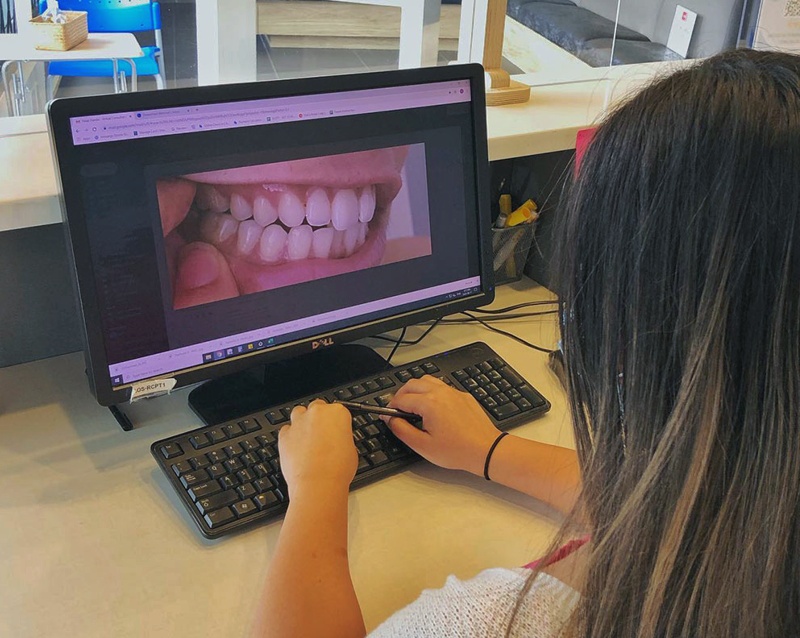
Does Invisalign work for crowded teeth? Should I get braces for an overbite? We hear these types of questions a lot from our Abbotsford, Surrey and Langley braces and Invisalign® patients before they kick off their orthodontic treatments. As certified specialists in orthodontics, Dr. Vishal Sharma, Dr. Everett Lin and Dr. Julia Koo, specialize in diagnosing, treating and preventing irregularities of the teeth and jaws and they’re experts in using appliances like braces and Invisalign® to give patients straighter teeth and more functional bites. While every patient is unique, these are the bite problems we see most often at our practice, as well as the orthodontic treatments we may recommend to address them.
Key Highlights:
Teeth are as unique as fingerprints, which means patients’ bite concerns and treatment plans will vary. However, the most common orthodontic problems we see at Aura Orthodontics are crowding, spacing, overbite, underbite, crossbite and open bite.
For many issues, especially when they’re due to the alignment of the teeth as opposed to the size or positioning of the jaws, metal braces, clear braces, Invisalign or Invisalign Teen alone could be used to straighten the teeth and help the bite come together properly.
When a bite problem is skeletal in nature, such as an underbite, early evaluation and treatment while a patient is still growing can help prevent the need for corrective jaw surgery or more extensive orthodontic treatments later in life.
The only way to receive an accurate diagnosis and find out the best way to treat problems with your bite is to visit a certified specialist in orthodontics for an evaluation. They have the experience and training to diagnose, prevent and treat malocclusions, or an improper bite.
What is Crowding and How is it Treated?
When there isn’t enough space for the teeth to fit normally within the jaws, it’s called crowding. Teeth might stick out, get blocked out of line, twist or overlap. Crowded teeth can be genetic, such as in a case of an imbalance in the tooth-to-jaw-size relationship or teeth that are just too large. However, crowding is also commonly caused by the early loss of baby teeth. It’s important to treat crowding because crowded teeth are harder to properly brush and floss. This can lead to tooth decay and gum disease. Having aligned teeth will allow you to clean them more effectively and improve your oral health.
So, back to the earlier question, does Invisalign work for crowded teeth? What about braces? Yes, in many cases, we can treat crowded teeth with metal braces, clear braces, Invisalign or Invisalign Teen. Sometimes, we may also have to recontour the teeth if they’re too wide. In severe cases of crowding, when it’s caught early while a patient is still growing, we may use appliances to expand the jaw prior to braces or Invisalign treatment. We only remove teeth as a last resort.
Another important point to mention when talking about crowded teeth is that if your child does lose a primary tooth before they’re supposed to, seeing your dentist or orthodontist is ideal because they can use a space maintainer to save space for the unerupted permanent teeth and help prevent excessive crowding.
What is Spacing and How is it Treated?
Spacing, sometimes called gap teeth in non-doctor speak, is when there are gaps between two or more of the teeth. Spacing can be caused by teeth that are too narrow for a wide jaw, missing teeth or certain oral habits. While spacing is a cosmetic concern and can make you feel self-conscious about your smile, it can also have a negative impact on the health of your gums and even lead to jaw bone loss.
Thankfully, closing gaps between the teeth is typically pretty straightforward. Many times, we can get great results by using clear braces, metal braces, Invisalign Teen or Invisalign for spacing.
What is an Overbite and How is it Treated?
An overbite is characterized by upper front teeth that overlap the bottom teeth. The majority of people have some amount of overbite, however, when the space between the upper and lower teeth is too large, it’s a concern. If not addressed, an overbite, or deep bite, can lead to uneven wear of the teeth, as well as jaw pain. It also makes the top teeth more susceptible to injury. An overbite is usually genetic though it can also be caused by oral habits like prolonged, aggressive thumb sucking.
So, does Invisalign work for an overbite? Will braces be effective? When it comes to how to fix an overbite, it depends on the severity. For a minor or moderate overbite braces and Invisalign may work on their own. Often, we’ll also utilize braces rubber bands or with Invisalign, tooth-colored Invisalign attachments and rubber bands, to get more leverage and help facilitate complicated movements.
For a severe overbite that’s skeletal in nature, early evaluation is key. If we spot the issue in childhood, we can often use certain appliances and braces to advance the lower jaw and help the upper and lower teeth come together properly. This allows patients to avoid the need for corrective jaw surgery down the road.
What is an Underbite and How is it Treated?
An underbite is when the bottom teeth sit in front of the top teeth. It happens when the upper and lower jaw grow at different rates. An underbite can cause difficulties with chewing and speaking properly and often results in the uneven wear of the teeth. It’s very important for kids with an emerging underbite to be evaluated early by an orthodontist. This way it can be treated while they’re still growing to avoid surgery.
As for how to fix an underbite, in kids, at around seven or eight years of age, we’ll use appliances to guide jaw growth and advance the upper teeth and jaw. This is usually followed by braces or Invisalign Teen treatment when they’re teeangers. While there are certain cases of underbites in adults that can be treated with braces or Invisalign in conjunction with extras like rubber bands, many times, especially in moderate to severe cases, surgical orthodontics is the best option. This is where we combine corrective jaw surgery with braces or Invisalign.
What is a Crossbite and How is it Treated?
A crossbite is when some of the lower teeth are in front of the upper teeth when the jaw is closed. There are two types of crossbites: an anterior crossbite and a posterior crossbite. An anterior crossbite, or front crossbite, is when one or more top teeth are behind one or more bottom teeth towards the front of the mouth. A posterior crossbite, or back crossbite, is when the lower teeth are in front of the upper teeth in the back of the mouth. Crossbites can be caused by losing primary teeth too early, genetics, trauma or oral habits. Since patients will often shift their jaw to one side to compensate for a crossbite, if it’s not treated, over time it can lead to permanent changes in the jaw and face.
When treating an anterior crossbite, braces or Invisalign will often be effective in aligning the teeth and helping the bite come together correctly. Fixing a posterior crossbite can be slightly more involved. If we detect the posterior crossbite when a patient is still growing, we may recommend two-phase orthodontic treatment depending on how severe it is. In phase 1 treatment, we’ll expand the upper jaw with an appliance. Then in phase 2, we’ll align the teeth and finetune the bite with metal braces, clear braces, Invisalign or Invisalign Teen.
What is an Open Bite and How is it Treated?
An open bite is when the top and bottom teeth don’t meet at all when the mouth is closed. As you can imagine, having an open bite makes it hard to chew and bite into foods. It can also interfere with speech. An open bite can be caused by genetics or oral habits like prolonged and aggressive thumb sucking, pacifier use or tongue thrust. Depending on how severe the open bite is and when we diagnose it, we might use appliances first followed by braces or Invisalign treatment. Other times, we may be able to create a functional bite with braces or Invisalign on their own.
From crowding to an overbite, we are able to address a wide range of bite problems with orthodontic treatments. By determining the underlying cause of the issue, Dr. Sharma, Dr. Lin and Dr. Koo can then create a personalized treatment plan to straighten the teeth and align the bite. To find out if you could benefit from Abbotsford, Surrey or Langley braces or Invisalign treatment, schedule an in-person or virtual consultation at Aura Orthodontics today!





